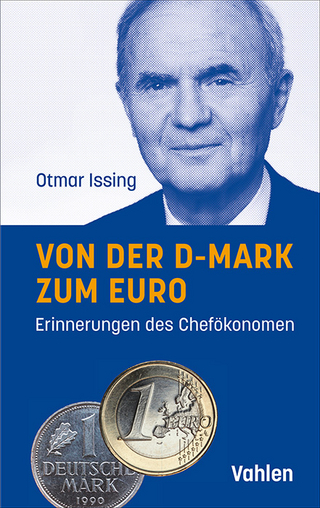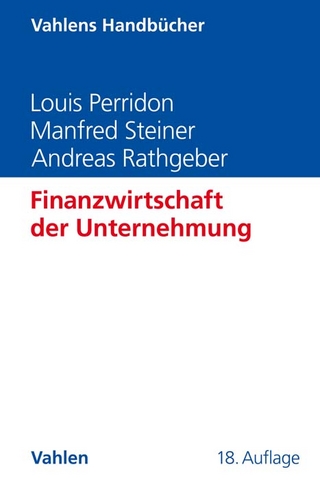
Microfinance, EU Structural Funds and Capacity Building for Managing Authorities
Palgrave Macmillan (Verlag)
978-1-137-51512-4 (ISBN)
This book presents a study of capacity building and structural funds in public managing authorities for the microcredit sector. It presents two surveys to highlight the strengths and weaknesses of the managing authorities' capacity building. The first survey investigates the authorities' need for and interests in capacity building activities, assessing the areas in which capacity building support is needed, and explores the different types of support offered. The second survey analyses the results of the microcredit and microfinance programming activity, investigating its target groups and other operational features. It examines the key monitoring and reporting issues involved in this activity, before analysing the regulatory framework of the microcredit and microfinance sector.
This book presents an in-depth analysis of structural funds and their management by policy-makers in the European convergence regions. It explores the interests of managing authorities, microcredit institutions, operators and other financial intermediaries involved in microcredit programming activities, and offers some core strategic and operational recommendations for the use of structural funds in the microcredit sector.
Giovanni Nicola Pes is the Director of the Planning and Research Department at the National Italian Agency for Microcredit. He is also a Member of the fi-compass expert group (European Commission) and President of the Credit and European Structural and Investment Funds (ESIF) Committee of the L'Associazione Nazionale per lo Studio dei Problemi del Credito (ANSPC), Italy. He collaborates with several Universities as a lecturer. He is the former Director of the European Capacity Building Project for the Public Administration, and previously held office in the capacity of Manager and Consultant with several international organizations. He was Chief Editor of the Microcredit and Development Policies Observatory for the journal Microfinanza, and contributes articles to various specialized journals. Pasqualina Porretta is Senior Lecturer of Banking and Finance at 'Sapienza' University of Rome, Italy, where she teaches risk management in banking and insurance, and derivatives. She is also a member of the academic board for the PhD in Management, Banking and Commodity Science at 'Sapienza' University of Rome. Her main research interests are risk measurement and management (credit risk, market risk, liquidity risk, counterparty risk), capital regulatory framework, financial derivatives, credit guarantee institutions and microcredit. She acts as a consultant and trainer for various financial intermediaries, microfinance institutions, public entities and consulting firms.
List Of Charts List Of Tables List Of Figures List Of Boxes Notes On Contributors Acknowledgements Forward Mario Baccini Introduction Gianfranco Verzano PART I: EU STRUCTURAL FUNDS, MICROENTERPRISE AND NON FINANCIAL SERVICES 1. Financial Crises And EU Credit Access Policy; Francesco Minnetti, Pasqualina Porretta And Ervin Sinani 1.1. Methodology And Purposes Of The Research 1.2. Small Businesses And Micro-Enterprises In The EU Economy: Introduction 1.3. The Importance Of The Smes In The European Economy 1.4. Typical Financial Profiles, In Particular With Regard To Micro-Enterprises 1.5. The Supply Of Credit In The Years Of Crisis 1.6. Some Summary Considerations On Data Examined 1.7. Access To Credit In The European Commission'view 1.8. European Investment Bank: Mission And Operating Methods 1.9. What Is The EIF 1.10. The Main Financial Instruments 2007-2013 1.11. GIF Statistical Data 1.12. The SMEG Statistical Data 1.13. The CBS 1.14. Financial Engineering Instruments 1.14.1. JEREMIE1.14.2. The Advantages Of The JEREMIE Programme 1.14.3. JESSICA 1.14.4. JASPERS Statistical Data 1.14.5. JASMINE Summary Of Data Collected On Financial Engineering Instruments 1.15. COSME 2014- 2020 1.16. EFG 1.17. LGF 2. EU Cohesion Policy And Micro-Finance; Giorgio Centurelli, Pasqualina Porretta, Fabrizio Santoboni 2.1. Cohesion Policy, EU Structural Funds And Financial Engineering Instruments: Regulatory Framework And Operational Features Under The Programming Periods 2000-2006 And 2007-2013 2.1.1. The Regulatory Framework In The Programming Period 2000-2006: First Implementing Provisions In Regulation (EC) No. 448/2004 2.1.2. The Regulatory Framework Of The Programming Period 2007-2013: Specific Features Of The Financial Engineering Instruments The General Regulation (EC) No. 1083/2006 And Implementing Provisions In Regulation (EC) No. 1828/2006 The Coordination Committee Of The Funds (COCOF) Notes 2.2. Financial Instruments In The Cohesion Policy 2014-2020: Regulatory Framework 2.2.1. The Main Amendments Compared To Previous Programming Periods 2.3. The Control System 2.4. Structural Funds And Micro-Finance 2.5. Implementing A Micro-Finance Programme Through The Structural Funds 2.5.1. Some Examples In Europe 3. EU Financial Engeneering And Microfinancenon-Financial Service. A Case Study; Maria Claudia Costantini, Maria Doiciu, Stefanie Laemmermann, Andrea Nardone, Giovanni Nicola Pes 3.1. The ESF And The Credit Access Of Micro-Enterprises 3.2. The ESF And Access To Credit For Microenterprises. A Case Study From Germany 3.2.1. History Of Microfinance In Germany Appraisal Of ESF Support For Microcredit In Germany 3.3. Microfinance And Non-Financial Services. The European Resources To Sustain Non- Financial Services 3.4. The New European Plans 3.5. Non-Financial Services: Advantages And Operational Features 3.5.1. Types Of Non-Financial Services 3.5.2. Who Funds The Non-Financial Services? 3.6 Partnerships In Delivery Financial And BDSS Services To The Micro Credit Beneficiaries In Romania 3.6.1. Case Study 1: Partnership In The Delivery Integrated Financial And Business Development Services. FAER NBFI And FAER Foundation 3.6.2. Case Study 2. Partnership In The Delivery Of Integrated Financial And BDS Services: Rocredit -NBFI And Eurom Business Consulting Company 4. Micro-Finance And Capacity Building In The EU Policy; Alessandro Cardente, Perrine Lantoine, Fulvio Pellegrini, Giovanni Nicola Pes, Pasqualina Porretta, Paolo Rita, Fabrizio Santoboni 4.1. Microcredit In The New EU Programmes: The Role Of The Italian National Agency For Microcredit And The Capacity Building Project Microcredit In The New EU Programmes 4.2. Micro-Leasing, Micro-Insurance, Social Housing: The New Frontiers For European Micro-Finance 4.3. Micro-Leasing: Introduction And Capacity Building Project Issues 4.4. Micro-Insurance: A Solution Just For The «Developing Countries»? 4.4.1. Introduction 4.4.2. Micro-Insurance: Definition, Literature And Regulatory Profiles 4.4.3. Micro-Insurance: Subjects Involved 4.4.3.1. Provision Of Micro-Insurance 4.4.4. Demand For Micro-Insurance 4.4.5. Micro-Insurance: Products And Distribution Channels 4.4.6. Micro-Insurance In The Developed Countries: Strengths And Weaknesses 4.4.7. Some Conclusions On Micro-Insurance 4.5. Social Housing: Introduction And The Capacity Building Project Issues 4.5.1. New Developments Of Housing Policies In The European Union 4.5.2 Social Housing And Housing Micro-Finance 4.5.3. The Capacity Building Project. Social Micro-Credit To Support Local Housing Policies. New Instruments For Social Inclusion 4.5.4. Possible Developments Within The Programming Period 2014-2020. The Italian Case 4.6. Housing Microcredit: The French Case 4.6.1. Context Of The Experimentation 4.6.2. Main Characteristics Of Housing Micro-Credit 4.6.3. A Shared-Value Approach 4.6.4. Lessons Learned: First Insights PART II: THE CAPACITY BUILDING SURVEYS: RESULTS AND REFLECTIONS 4. Capacity Building Surveyes; Riccardo Graziano, Porretta Pasqualina, Giovanni Nicola Pes, Cristiana Turchetti, Matteo Re 5.1. Methodological Framework: Aims, Questionnaires 5.2. The Managing Authorities' Interest And Needs In Capacity Building Activities 5.3. The Questionnaire: The Investigation Area 5.4. The Sample Used 5.5. Main Results Thematic Objectives Ex-Ante Conditionalities Programming, Management, Implementation, Evaluation & Monitoring And Financial Management And Control Of The Operational Management Management Implementation 5.6. Conclusions On First Survey 5.7. Second Survey: Aims, Investigation Areas And Sample Used 5.8. The Main Results Of The Survey: First Considerations 5.9. Reflections On The Second Survey
| Reihe/Serie | Palgrave Studies in Impact Finance |
|---|---|
| Zusatzinfo | XXX, 286 p. |
| Verlagsort | Basingstoke |
| Sprache | englisch |
| Maße | 140 x 216 mm |
| Themenwelt | Naturwissenschaften |
| Sozialwissenschaften ► Politik / Verwaltung ► Staat / Verwaltung | |
| Betriebswirtschaft / Management ► Spezielle Betriebswirtschaftslehre ► Bankbetriebslehre | |
| Wirtschaft ► Volkswirtschaftslehre ► Mikroökonomie | |
| Wirtschaft ► Volkswirtschaftslehre ► Wirtschaftspolitik | |
| ISBN-10 | 1-137-51512-0 / 1137515120 |
| ISBN-13 | 978-1-137-51512-4 / 9781137515124 |
| Zustand | Neuware |
| Informationen gemäß Produktsicherheitsverordnung (GPSR) | |
| Haben Sie eine Frage zum Produkt? |
aus dem Bereich


